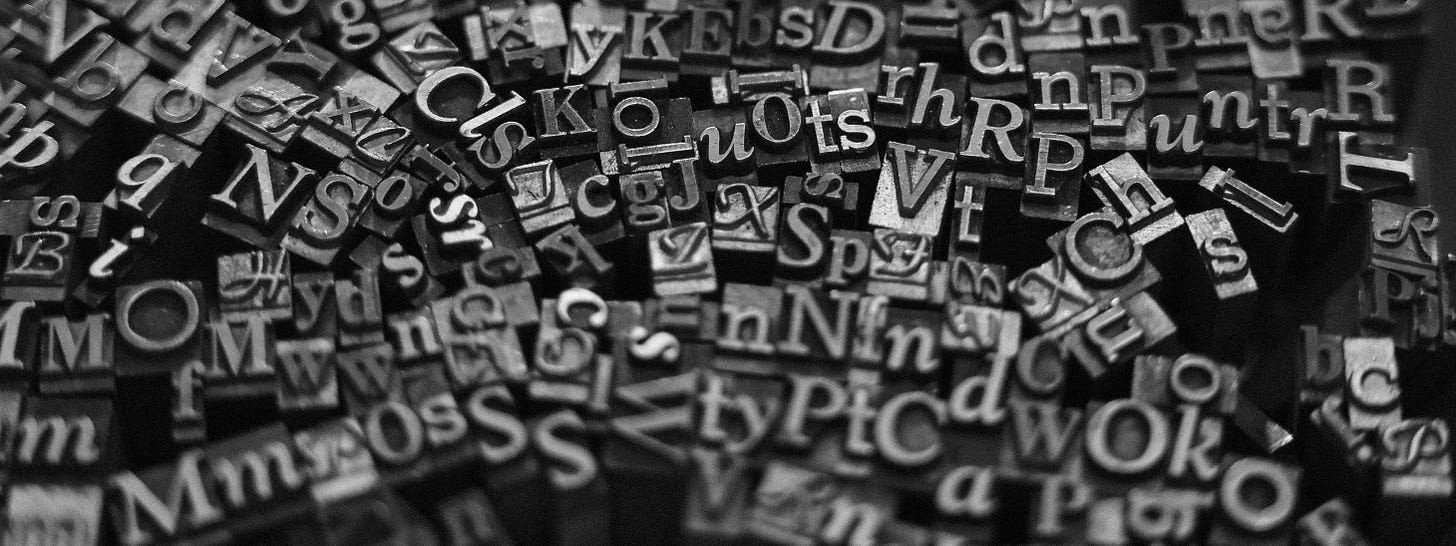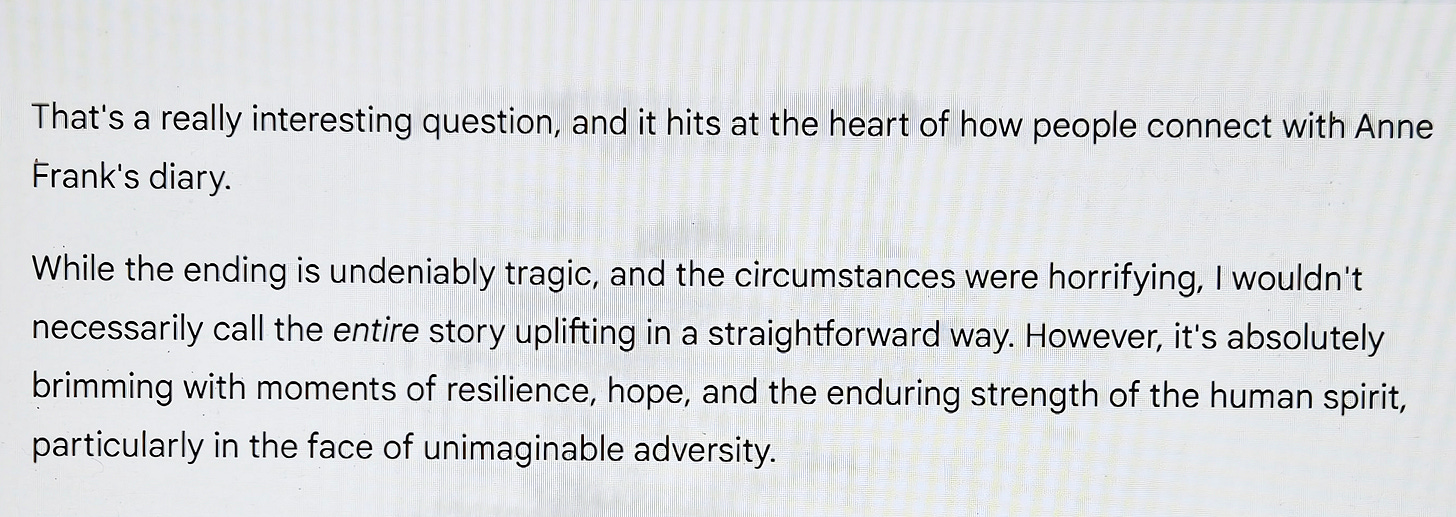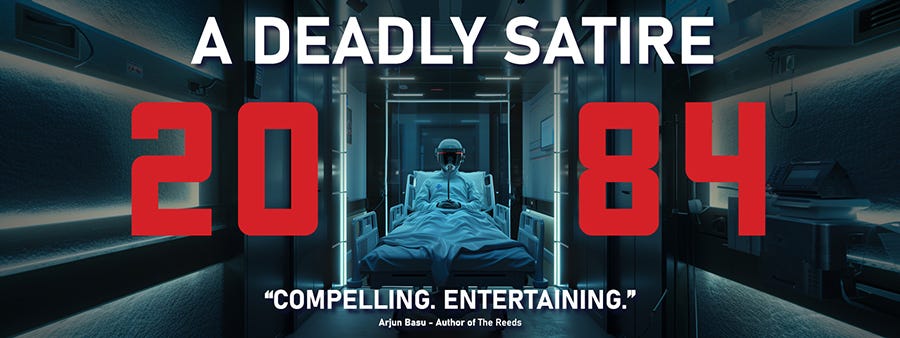Shunning Spotify, fascinating fonts, and are chatbots humanity’s superpower?
From GeminI to GeminWE
In researching this issue’s 1Q quote, I was curious to see what AI would say about the emotional arc of Anne Frank’s Diary. So I asked Gemini and received a pretty straightforward answer that made total sense. Here’s an excerpt:
What jumped out at me was that the answer came in the first person. I assume I’ve seen this kind of thing before in a chatbot response – “I wouldn't necessarily call the entire story uplifting in a straightforward way.” – but in this instance the “I” set some mental wheels in motion.
Now, I understand the corporate imperative behind making LLM chatbots seem human. Whether it’s the chatty, “Sure, I can help you with that!” or automatically generated podcast voices, the personification of AI tools is a design feature that makes them more appealing than robotic monotones or stripped-down facts and bullet points. This is no surprise because any human interface works better when it aligns with our natural assumptions and reflexes. When we’re told that we’re in a chat, we expect there to be a person on the other side of the screen.
But if ever a tool was less of an “I” and more of a “we”, it’s a chatbot. Why do I think that? Let’s wind back the clocks half a millennium.
Johannes Gutenberg’s invention of metal movable type around 1450 led to a boom in publishing in Europe. The proliferation of printing presses provided the means for humanity’s collective intelligence to multiply and spread faster and further than ever before.
Fast-forward to the late twentieth century. The development of the internet triggered an explosion of shared text in digital format. Not only did the World Wide Web spawn myriad web pages, blogs, and eventually posts, Google launched Project Ocean in 2002 – the search engine company’s effort to scan every book in the world. Within two years, Project Ocean had digitized about 25 million books.
If we slow-forward to the 2020s we are living in today, generative AI has vacuumed up all of these texts into immense databases that fuel Large Language Model chatbots such as ChatGPT and Gemini. In other words, when we query an LLM we are accessing the knowledge and imaginings of vast numbers of people, alive and dead. This is “we” on a scale beyond comprehension. And despite their failings, LLMs allow us to mainline our shared wisdom (and occasionally our shared stupidity!) directly into our brains.
It bothers me that the corporations behind chatbots purposefully inflect text outputs in the first person. Why? Because it’s a deceptive business practice to personify strings of probabilistically determined text tokens in order to create the illusion that the texts produced come from a trusted single source. What’s worse, expressing opinions from an invisible “I” obfuscates the common ownership of our collective intelligence. Corporations such as Meta, Alphabet, and OpenAI have taken humanity’s superpower – the “wisdom of the crowd” – and are selling it back to us in neat packages. Ironically, ChatGPT agrees:
We may use it for good or for bad, but either way, our accumulated wisdom does not belong to a corporation. It’s a plurality. It’s a “we”. No matter how uncanny it might sound, we'd all be better off if chatbots started to output text in the first-person plural. What if Gemini's text about Anne Frank quoted above had been expressed like this: “We wouldn't necessarily call the entire story uplifting in a straightforward way.”? Yes, the “we” is jarring, but it’s important because it signals that a digital hive mind is operating under the hood of every LLM.
Whichever chatbot we’re using, the answers we receive do not come from a spookily human-like digital genius, they come from us. What we have done is – collectively – honed a wand/weapon through which we can now channel our superpower. And it should be up to us, not corporations, to wield it wisely.
Designers comically saving pants
When brands try to coin their own slang, like when Cheetos concocted the word “Cheetle” for the Cheeto dust that sticks to your fingers, it doesn’t always catch on — in this case, not even after erecting a giant commemorative statue in Cheadle, Alberta, in 2022.
But the lived reality of Cheetle, on the other hand, is a pressing issue that Cheeto addressed magnificently through their recent invention, Cheeto Pants. The pants are colour-matched to Cheetos, with towel-like sections near the pockets specifically for wiping Cheetle off your fingers: “The pants stand out. The Cheetle blends in,” the site proclaims. In their promotional video, designers react to the cheesy pants in disbelief, with comments like “This is a joke, right?” and “Absolutely not.”
Unfortunately, consumer demand met a supply crunch, and the pants sold out in a flash. Now all the Cheetos Pants site can do is direct visitors to other orange pants on the internet using their “advanced search technology.” Hopefully Cheetos doesn't wipe their hands of Cheeto Pants entirely and finds a way to make them available for sale again soon.
Swifties accidentally saving dogs
If you can harness the fervour of the Swifties, you can achieve anything. In an ingenious marketing move, the French animal adoption platform Seconde Chance changed the names of all black dogs on its site to “Taylor Swift” so they would come up in searches for Taylor Swift’s song “The Black Dog.” The goal was to increase traffic to the dogs’ profiles and thus combat “Black Dog Syndrome,” the sad phenomenon of black dogs getting adopted less often. And doggone it, it worked!
Profile views for black dogs on the site and adoptions dramatically increased, and the campaign went viral on social media, spreading awareness even further. And the campaign didn’t cost a thing! It just goes to show what a unique, funny, and well-intentioned idea (and Swifties) can do.
Paints purposefully saving the planet
From black dogs to paint that turns from black to white… Thermochromic paint is going beyond mood rings and colour-changing Polly Pocket shoes to the thermoregulation of entire houses. Designer and inventor Joe Doucet has prototyped a paint that changes colours with the seasons: darker in the cold to trap heat, and lighter in the heat to reflect it. The idea’s a poetic one, inspired by leaves changing their colours with the seasons, and also a practical one, with the potential to save homeowners an average of 20-30% of the energy used to heat or cool a building.
The climate-responsive paint darkens to almost black at any temperature below 25°C and brightens to any colour of choice above 25°C, mixable with any other paint colour. Using light colours for houses in hot places is a long-used strategy (e.g, the “pueblos blancos” or “white towns” of Spain), as is using dark colours in cold places (e.g., Scandinavian black houses), but this design is flexible enough to be used in volatile climates as they become even more capricious with climate change.
Currently, the paint can only last a year without degrading, but once it has been upgraded, Joe Doucet x Partners (JDXP) plans to license the formula to paint manufacturers and bring it to the market. JDXP’s core elements of design, innovation, and sustainability are perfectly encapsulated by this product, creating, as their “About” page explains with a Venn diagram, some truly “cool shit.”
Anne Frank, schoolgirl
“Crying can bring relief, as long as you don’t cry alone.”
The world is a little, shall we say, upsetting right now. It’s okay to shed a few tears. But as this quote from the bittersweet diary of Anne Frank testifies, sadness shared with an empathetic listener can be a sadness halved.
Shunning Spotify
This short episode of The Indicator (from NPR’s Planet Money) explores the fall, rise, fall, and rise of vinyl records. How popular are LPs right now? Kendrick Lemar’s new album, GNX, has sold close to 100,000 copies on vinyl. Can all those fans be early-2000’s hipsters in Brooklyn who swoon with nostalgia when rewatching High Fidelity? Probably not. And behind the vinyl boom is one behemoth located in, of all places, Eastern Europe.

Czech company GZ Media manufactures over 70 million records a year, while the biggest US-owned vinyl plant only makes about 9 million. Listen to hear a capitalist success story that starts with… communism.
Fascinating font foundries
Zachary Crockett, host of the Freakonomics-produced Economics of Everyday Things podcast, shares his research into the history of professional fonts and why they’re such a big business.

As Crockett puts it, “There are more than a million fonts available on the Internet. And every year, designers license more than a billion dollars worth of them to marketing firms and publishers. But it’s not an easy industry to make money in. A successful font has to be unique enough to stand out and familiar enough to be legible.”
The history of the future
When I published my latest novel, 2084, last summer, I knew it was a cautionary tale. The future I depict is superficially utopian, à la Brave New World, but the title gives more than a nod to Orwell’s dystopian 1984.
I was determined to ground my fiction in reality while avoiding clunky world-building as the narrative progressed. So I made a decision very early on in the writing process to develop a preface that sketched the political and economic path from our real-world present day to my imagined future.
Little did I know that events would transpire to make my one-page History of the Future look frighteningly prescient. My seemingly outlandish proposal was that the US-Canadian border might melt away as new polities emerged from a schism between urban-centric tech corporations and climate-denying religious traditionalists.
Where are we actually headed? Read the news. Or… read my History of the Future, which I have just published as a free, standalone piece on Medium. Let me know what you think!
Did you enjoy this issue of Discomfort Zone? You can comment directly in the Substack app or drop me a line by emailing me at john@johnbdutton.com.
And why not connect with me on LinkedIn if you haven’t already?
FOMO food research and writing by Silvia Todea, editing by John Dutton.
Legal disclaimers:
All images in this newsletter that are not the property of the author are used with permission or reproduced under the fair use provisions of the Canadian Copyright Act while giving appropriate credit.
The content published in this newsletter represents the private views and opinions of John B. Dutton and are not in any way connected to his role with the National Film Board of Canada.

















